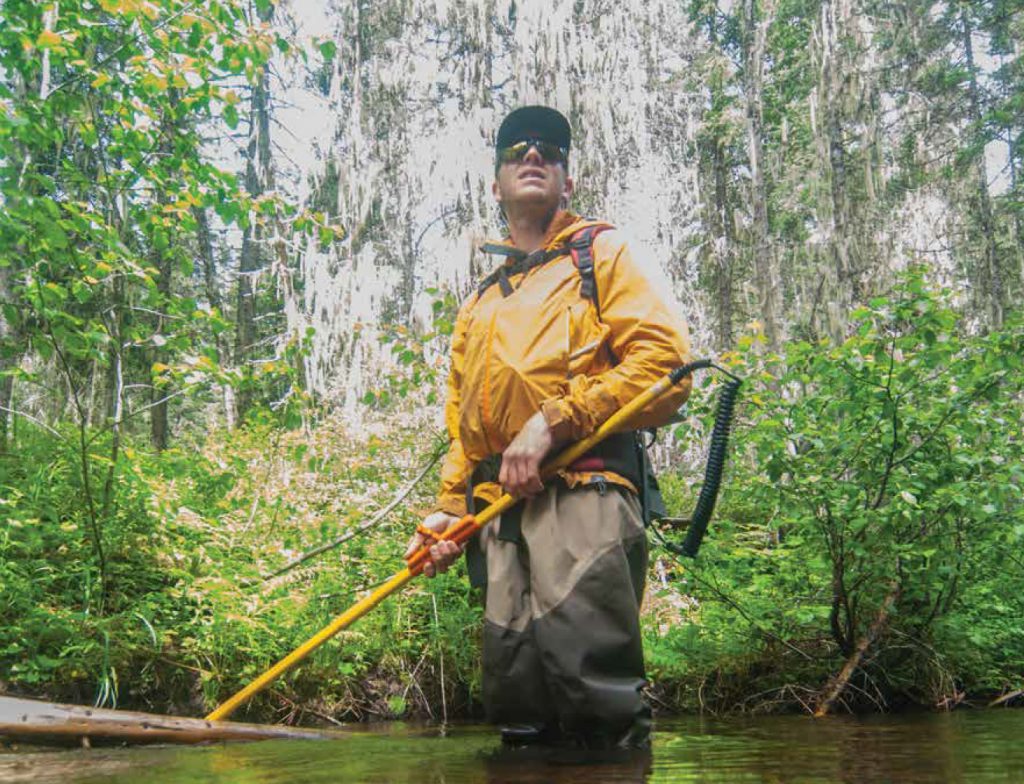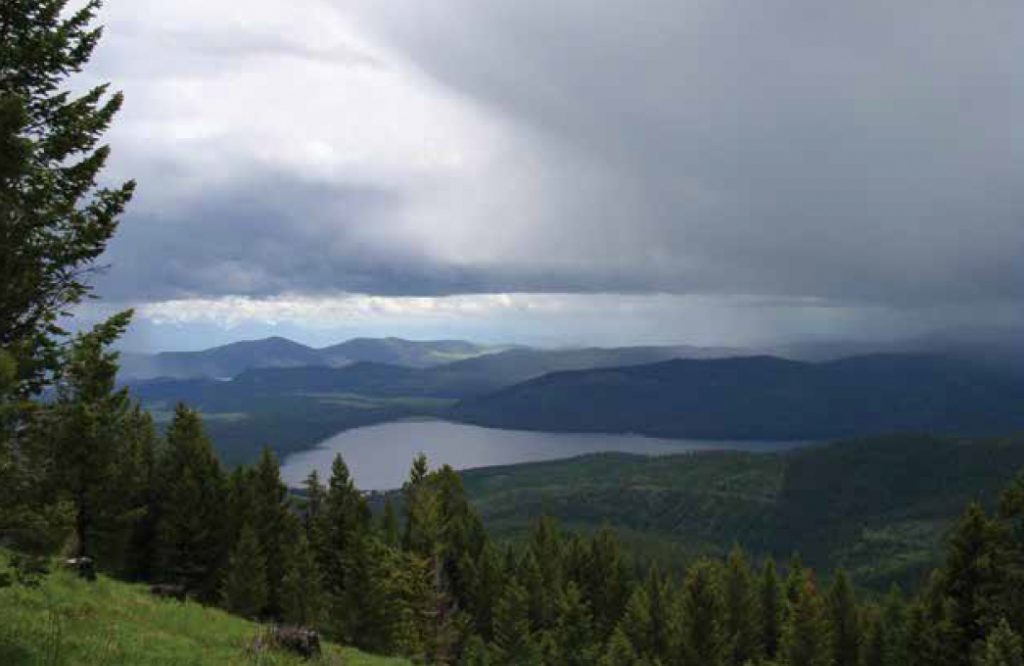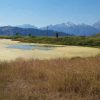A fish detective, the effort to stop illegal invasive species introductions, and a long history of a fish management culture clash
One summer day in 1992, two teenage boys fishing Lake Mary Ronan watched a man dump a cooler of fish near the lake outlet and leave. Sensing something amiss, the boys wrote down the license plate number and then quickly netted a couple dozen small yellow perch. They called Montana Fish, Wildlife, and Parks, and reached Jim Vashro, the state fisheries biologist at the time, who recalls making a split-second decision that day. “We just happened to have a leftover barrel of rotenone in Kalispell.” (He describes the situation as an ask-for-forgiveness-later type of decision, knowing that the normal channels for rotenone approval would come too late for the situation he was faced with.) Vashro arrived within hours and treated the bay with rotenone, a powerful chemical that fatally interrupts oxygen intake of gilled organisms at the cellular level. Any desirable fish caught in the crossfire would be replaced from hatchery stock. The treatment of the bay yielded a couple dozen more perch.

Yellow perch, a popular sport fish native to Atlantic and Arctic Ocean watersheds including the Great Lakes and Mississippi River Basins, but not to any watershed west of the continental divide, are spiny with cartilage and voracious. Salmonids such as kokanee and rainbow are smooth and fleshy: good eating for anglers and predators alike. The introduction of yellow perch in Lake Mary Ronan meant adding a new predator to the system, something that could both prey on and compete with the existing salmonids, a wrench thrown into a delicate biotic system.
At the time, Vashro feared if the perch took hold and spread across the lake, eradicating them would cost up to $300,000.
“At least two perch got away from us though.” Vashro, now retired from more than 30 years in fisheries management, purses his lips as he recalls the incident over coffee.
In the 27 years since, yellow perch exploded to about 80 percent of the lake’s biomass, wiped out the lake’s westslope cutthroat, and created a management situation where Montana Fish, Wildlife, and Parks (known regionally as FWP) now spends $40,000 per year to stock kokanee and rainbow trout. The estimated cost to rotenone the entire lake and restock desired species is now around $1 million, in addition to the burden of years of permitting and public comment. The perch have simply become part of the lake’s biome.
Tax payers, state coffers, anglers, and nearby communities take the hit for the short-sighted and short-term benefit of the “bucket biologist,” anglers who bring in new species with the intent to improve their own fishing opportunities. Whether their intent lays in convenience, preference, or simply nostalgia, their actions can have far-reaching effects. Such bucket biologists are the bane of wildlife managers, who already have a hard job. They are tasked with maintaining ecological health as well as providing sportfishing opportunities, not to mention juggling the fundamental and competing philosophies that underpin each of those, in waterways transformed by decades of illegal fish introductions and misguided stocking programs inherited from a bygone era, all on a short budget and with little sympathy from the public. One biologist tells me frankly, “We can’t do everything we’d like to, and we can’t make everyone happy.”
![]()
A long history of heavily managed fisheries doesn’t help the case against the bucket biologist. State-sponsored bucket biology of the 19th and 20th centuries is responsible for much of the sport fishing touted across the West. This was a time where fisheries managers acted without fully understanding larger ecological effects of introducing a species. Two of Montana’s beloved trout species are nonnative. Though rainbow trout are native to the upper Kootenai River, which flows south from British Columbia into a tiny corner of northwest Montana, they are nonnative and have been widely introduced elsewhere across the state. Brown trout were introduced from Europe in the 1880s. Very few waterways in Montana house a true native assemblage of aquatic species. Fisheries managers largely manage for ecological stability in a system, mated with some semblance of public whim and what anglers want in a fishery.
Historically, a waterfall just downstream of Lake Mary Ronan meant the lake had no native fish. In the 1890s, an agent for the Flathead Indian Reservation, whose wife is the namesake of the lake, introduced the first fish to the lake. Fishing became popular there, and by 1913 the Somers State Fish Hatchery was stocking cutthroat and rainbows. Numerous other species, including kokanee, as well as chinook and coho salmon, Yellowstone cutthroat, grayling, brook trout, largemouth bass, and sunfish, were introduced over the following century. Eventually, three salmonids—the cutthroat, kokanee, and rainbow trout—came to comprise a stable ecosystem that, though not native, supported well-liked sport fishing and provided a very important kokanee brood stock to feed the state’s fish hatcheries and stocking programs.

While early state-sponsored fish stocking was not grounded in science, decades of improved ecological understanding have contributed to the decision-making actions of fisheries managers, who still utilize stocking programs as a tool across the state. Bucket biologists, in contrast to fisheries managers, do not take into account the drastic ecological and economic effects that may come with an introduced species. Many bucket biologists consider their actions to be for the ultimate benefit of the fishery, though recent history suggests long-term negative impacts.
“It’s just a boom and bust cycle.” Vashro describes how a bucket biologist’s introduced species such as pike, perch, or walleye, with no competition, will initially blow up and be good fishing. But then they reach carrying capacity, and, like in Lake Mary Ronan, there will be a few 10- to 12-inch perch, but many more 4- to 6-inch ones. “No one wants to fish that.”
One of Vashro’s legacies was establishing a state-wide database of over 600 unlawful fish introductions, most of which resulted in decreased fishing opportunities. He estimates that just a couple of the 600 unlawful introductions documented in Montana improved the fishing. Furthermore, improved fishing conditions in the eyes of the bucket biologist are not improving the angling opportunities for the rest of the sportsman in the state or the long-term viability of a fishery. Introduction, particularly of an apex predator, might create a short-term boom (as it fills up on a surplus of prey), followed by a crash of both that species, as well as the pre-existing species that are now predated on or out-competed.
Vashro has even heard of bucket biologists with a 10-year plan. “They just move from lake to lake, introducing a species and fishing the boom, then moving on to the next boom as the lake busts behind them.”
![]()
On a Saturday in June, I walk past a stock tank of sodas outside a school house turned community center about five miles from Lake Mary Ronan and make my way through small clusters of people milling around plates of home-baked cookies and carafes of coffee.
The community center is serving as a venue for the Friends of Lake Mary Ronan open house. Fifty-odd lake residents, anglers, and other community members gather, taking seats in an assemblage of folding chairs, old church pews, easy chairs, and couches. I settle for an old school desk, my notebook taking the majority of the surface. On the docket for the afternoon are presentations on water quality, septic upgrade cost-sharing grants to address leaks, as well as illegal fish introductions.
The crowd, gathered in the interest of their lake, which some describe as dying, is charged. They cite a variety of concerns: decreased fishery productivity, eutrophication related to development, increasing numbers of nonnative cormorants feeding on the lake’s fish, and a newly introduced nonnative fish. Some care about algae and poor water quality disrupting swimming or boating. Some care about fishing for rainbow trout. Some care about fishing for perch. Others care simply about the lake’s kokanee brood stock. The perch population, spilled from that cooler in 1992, is on the bust end of its cycle, with a high population of stunted individuals.
Sam Bourret, in a blue plaid shirt with hands stuffed into jeans pockets, takes the stage last. In his mid-30s, Bourret, a fisheries biologist with Montana FWP based nearby in Kalispell, is here to talk about illegal fish introductions and the research he does to identify them. He clicks through his first few slides, flashing a bright smile with the slightest gap between his two front teeth as he mixes light-hearted jokes in with dense explanation of his otolith research.

“Oto: ear. And lith: stone.” Bourret enunciates slowly. “Oto-lith.” He has a goofy slide with a human ear superimposed on a fish and Stonehenge. For those a little foggy on their fish physiology or Latin, he explains, the otolith is the ear bone of a fish. As a fish grows, the otolith records the unique geochemical profile of the body of water where the fish lives. Similar to tree ring data, it provides a timeline of a fish’s life history. Bourret takes a slice of that otolith, using it to identify the body of water a fish came from, and subsequently, whether a drastic change in habitat has occurred, such as in the instance of a fish being moved to a new body of water. He takes a pause to pass a plastic sandwich bag containing actual otoliths around the room, adding that they make great earrings for fish lovers.
Bourret clicks to the next slide. In 2015, a commercial fishing crew contracted by FWP to remove nonnative lake trout raised the alarm when they unexpectedly plucked two walleye—toothy, nonnative predators, previously not present—from Swan Lake. Walleye are a big fish; the Montana record stands right around 17 pounds, though most are just a pound or two. While Montana fisheries managers stock and manage walleye for sport fishing east of the continental divide, they fear the threat walleye pose to westslope cutthroat west of the divide in places such as Swan Lake.
Bourret quickly jumped on the case. His slide shows a slightly oscillating line with a dramatic y-axis shift when the fish arrived in Swan Lake. By collecting and analyzing other walleye otoliths from Montana (there are just a handful of lakes, reservoirs, and associated rivers where walleye are found), Bourret identified the source of the introduced fish as Lake Helena, more than 150 miles away. A local paper picked up the story and dubbed Bourret “the Fish Detective,” a moniker he’s carried ever since.
This presentation at the community center isn’t his first in the region or the state. He has presented his otolith research everywhere from a “Science on Tap” event at a nearby brewery to the American Fisheries Society student chapter at Montana State University. Bourret knows his research isn’t catching bucket biologists, but hopes that the education piece that comes along with his presentations can continue to raise awareness and help shift the culture away from bucket biology, whether that be through the fear of being caught, or the understanding of the severe ecological and financial costs of managing an introduced species.
“This is 100 percent preventable,” Bourret tells me, shaking his head.
Vashro concurs. “Prevention is where it is at. People need to knock it off.”
![]()
Across the West, states are getting serious about stopping illegal fish introductions. Around the time of the 1992 perch release in Lake Mary Ronan, Montana FWP first designated reward money for informants who turned in bucket biologists. The current bounty on those responsible for the two walleye in Swan Lake that Bourret’s team identified is $30,000, offered by the state of Montana and Trout Unlimited.
Montana is not alone facing the issue of bucket biologists’ attempts to curate their preferred fishing spot. In Alaska, the fine for transporting a nonnative species to new waterways can be up to $10,000. In 2018, the state of Utah drained Kolob Reservoir near St George, treating it with rotenone after yellow perch, green sunfish, and bluegill—three species that threatened the endangered Virgin River chub and woundfin—showed up. When northern pike appeared in a Colorado reservoir in 2018, Colorado Parks and Wildlife, in conjunction with local and state partners, started paying anglers $20 for every pike pulled out of the reservoir and the White River. And after a bucket biologist released northern pike into Nevada’s Comins Lake in 2004, angler user days dropped from about 35,000 to an estimated 2,000. In 2015, Nevada spent $250,000 to remove the pike, but in 2017 someone released more northern pike into the same water body. The state has offered a $10,000 bounty for information about this latest pike introduction.

The license plate number those teens grabbed in 1992 at Lake Mary Ronan identified Gregg Mosely as the bucket biologist behind the devastating yellow perch release. Law enforcement located him and cited him; he received a restitution fine for FWP’s mitigation efforts and two years loss of fishing privileges. But when he received the bill to the tune of $1,500, he balked. The case ultimately went to the Montana Supreme Court in a jurisdictional feud, where Mosely successfully argued that the court in which he was charged did not have the power to levy restitution fines for a misdemeanor in excess of $500. The remainder of his fine was thrown out.
To this day, Montana has not paid out a major bounty for someone reporting any bucket biology. Of the 600 documented illegal introductions Vashro has cataloged, he points to about a dozen instances in the state where someone was prosecuted for an illegal fish introduction.
“It’s mostly the private pond vector,” he says. “Someone steps around the law to stock their own property with whatever, not realizing and not caring about the downstream effect.” He describes how one man put grass carp in his pond to help control the reeds so he could have a better pond habitat to train his hunting dog in. “Putting grass carp at the headwaters of the Columbia River watershed…” Vashro trails off, shaking his head. In that instance, the individual had forged import papers three times, ultimately earning himself a $3,500 fine for the removal of the species. In the end, it’s much easier for FWP to clean up unlawfully stocked private ponds than larger water bodies like Lake Mary Ronan, or instances when fish enter entire watersheds.
“We know people who know who is doing it,” Vashro tells me. “We even had an informant who knew who was introducing walleye to Noxon Reservoir. We were waiting for him to tell us the next time the guy was going to release the walleye, but he [the informant] went to jail for something else and clammed up.”
“We need a citation,” Bourret tells me. “Someone needs to get slapped with a big fine.”
![]()
Back at the community center, the projector screen flashes again. A murmur emerges from the crowd as Bourret explains what we are looking at. The slide shows the otolithic profile of a northern pike indicating the fish was born in Lake Mary Ronan. Pike are an aggressive predator, known to eliminate their own food supply within a couple years and turn cannibalistic in the absence of other prey. In eastern Montana, pike wiped out several prairie minnow species. While a sought-after sport fish, illegally introduced pike are a fisheries manager’s nightmare. This isn’t the first pike to be pulled from the lake. It’s the fourth that’s been turned in to FWP since 2015 and other sightings have been reported. But Bourret’s research indicates this is the first evidence of a pike born in the lake, which means the population is establishing. Just the day before, Montana FWP issued a mandatory kill order for any pike discovered in the lake.
Bourret concludes his presentation and begins to take questions. The first hand shoots up.
“Is having pike in this lake such a bad thing?”
Bourret sticks to the science, not taking the bait into what is obviously an emotionally charged debate. “We know pike are voracious. They may prey on the perch, but they are likely to prey on the kokanee and rainbows as well.”
A week later on Bourret’s porch, he talks more about the answer that man might have been looking for. “He wanted me to say that having an apex predator present in the lake would put pressure on the yellow perch and make better perch fishing. But we don’t know that. We, the FWP, have to be concerned about the effect that pike may have on kokanee. That’s Montana’s sole brood stock for the state’s hatcheries.”
By Ben Johnson
Ben Johnson is a former environmental educator and freelance writer who lives in northwest Montana.


